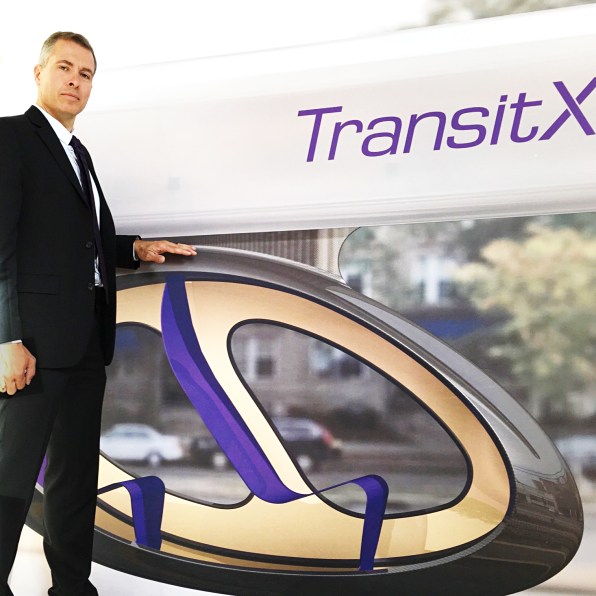Transit X’s plan would set up fast-moving, solar-powered personal transit units to whisk you anywhere you wanted to go.
Self-driving cars might not solve the problem of rush-hour traffic, and in cities with some of the worst commutes now–like L.A., where each driver wasted an average of 102 hours stuck in traffic last year–most commuters still don’t choose to take public transportation.
A startup called Transit X argues that we need a different form of mass transit to get people to stop driving. The company’s system, which it says will soon be deployed in the Philippines, will use networks of lightweight, automated, solar-powered pods. Each small pod is large enough for up to five people, and suspended from a narrow elevated rail 14 feet above the ground, tall enough that a semi truck can pass underneath. At a stop, passengers would enter their destination in an app or a kiosk, walk up to a small platform to board their own pod nearly immediately, and then take a nonstop ride to wherever they’re trying to go. (Each stop is designed to have an exit ramp for boarding, so it’s possible for other pods to pass by without stopping until their final destinations.)
“People don’t like to wait,” says Mike Stanley, CEO of Transit X. “They want to have a single seat and a private experience. So if you’re going to replace the dominant mode share of cars, you’d better give them something that they’ve already expressed a preference for rather than trying to force them into saying ‘use mass transit because it’s better for the environment.’”

The company hasn’t yet begun production of the pods, but has designed prototypes. Each carbon-fiber pod will weigh around 100 pounds, around 28 times less than an average car, and because they avoid the inefficiencies of car travel–which start and stop 20 times on a trip, and continually slow down and speed up, the pods will get the equivalent of 1,500 miles per gallon. That makes it possible to power the system with solar cells attached to the track. The support poles will hold large batteries; the pods will park where energy is available and charge while parked.
The stops are designed to take up less space on the sidewalk than bus stops–the poles could replace streetlights on sidewalks, and the system could provide lighting itself–but the company calculates that one track can carry the same number of passengers as a 12-lane highway. “If it can lure people away from cars through convenience, speed, and cost, Stanley envisions that roads could shrink, reshaping cities.
“You’re giving back road space to the city,” he says. “So think about the economic value of doubling the land area of your city.”
To work effectively, the pod systems would need to cover entire cities. “You have to think about a network, because the reason why we love roads is they go everywhere,” says Stanley. “Unless you can go everywhere, you’re not going to be able to replace them. So what we’re proposing is that we do this very fast shift, so you’re basically creating a sparse, road-like network over the entire metro area. Nobody else really understands that’s what you need, and you need to have the financing, the capacity. It’s not a multimodal future. It’s a universal mode.”
Because the system would reduce or eliminate most of the costs of public transportation–it doesn’t need land or drivers or fuel, the simple vehicles need less maintenance than other vehicles, and construction is far cheaper than building something like a subway system–the company believes its system is cheap enough to finance itself. The company will pay cities 5% in fees and taxes for the right to an easement for the space it uses. It believes it can profit even if the cost of tickets is very low. In the first system, which the company has signed a deal to build in a suburb of Manila in the Philippines, the operating cost will be less than 5¢ per passenger mile.
The company is not the first to try to popularize a system of self-driving pods or personal rapid transit–but none of the existing ones operate on a large scale. They remain an interesting thought experiment in what a fully rethought transit system could look like, though starting from the ground up may not be the most efficient way to innovate in the sector.
But the company says cities are interested, mostly as a way to address traffic and congestion. But the system also is more resilient than the status quo; in a major snowstorm or during a flood, when roads are inaccessible, it could continue to operate. And the solar-powered pods eliminate the pollution of other modes of transportation.
Electric cars, Stanley argues, aren’t a viable solution on their own because they don’t solve the problem of congestion (and depending on the current source of the electric power, may still cause pollution as they’re used). “I think there needs to be another narrative than ‘buy a Tesla, save the world,’” he says, adding, “What we see is that the car is what needs to be replaced.”
The startup plans to demonstrate a pilot system in Boston in late 2018.

![[Photo: courtesy of Transit X]](https://images.fastcompany.net/image/upload/w_562)